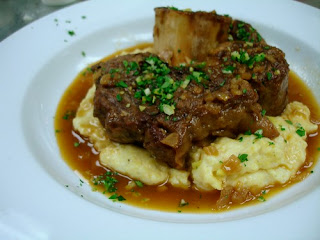Osso Buco.
www.flickr.com/photos/tannazie/2552435205/
Jarret de veau in French or Osso Buco in
Italian is the same dish with only slightly different herbs in the
recipes. Arguments over the vegetables
and how they are prepared will go on forever.
The most important part of this dish is the center bone; it is a marrow
bone and will provide much of the flavor and texture to the dish. The jarret is
a cut from a shin or shank of veal; the cut is across the bone and below the
knee; the meat on a veal shank surrounds the bone.
Photograph by courtesy of World to Table.
Under its French name jarret de veau or the dish’s Italian name osso buco and whether prepared in Italy, or in France, this is a dish that must be cooked very, very slowly to absorb all the flavors.
The cut for Jarret de Veau.
The marrow bone in the center will provide a great deal of the flavor and texture.
www.flickr.com/photos/46722918@N08/8638857938/
The meat along with white wine will have been braised for hours with the bone marrow adding its special magic. With a well-prepared jarret de veau on the first bite, you encounter a taste of the veal that will practically melt on your tongue; the combined flavors of the other ingredients will provide a symphony of complementary tastes. Whether in France, Italy or elsewhere well-trained chefs show their skills through a veal osso buco that keeps the customers returning.
For a veal osso buco, chefs may argue about the white wine used, how the vegetables are prepared, how much garlic and parsley is to be added and more. However, I write as a diner, not as a chef, and when you taste the gravy you will see how the chef has balanced the white wine, veal stock, olive oil, onions and garlic with the flavor and texture of the veal marrow.
A serving of a jarret de veau may vary
significantly in size. A calf just
weaned will provide the softest meat; however, I prefer a slightly older animal
that will provide more taste and, of equal importance, a more substantial
portion. In Italian, the name osso buco
just means a bone with a hole, and that all that is left when you have been
served a well-made jarret de veau.
N.B. Occasionally a French menu will
translate jarret de veau into English as a veal knuckle, which it is not.
A very large triple serving of jarret de veau
Your menu may also offer:
Jarret de Veau Rôti à la Sauge et aux Girolles – A veal shank braised together with sage and served with girolle chanterelle mushrooms.
Jarret de Veau Confit 12 Heures au Vin Blanc et Romarin - A veal shank slowly cooked for over 12 hours in white wine and rosemary. The veal confit may melt on your tongue.
Jarret de Boeuf. The same cut as a jarret de veau but the meat is beef, not veal.
Jarret de Bœuf Fondant, Sauce Ravigote – On this menu listing the chef says it is fondant,
practically melting. If it has been
cooked slowly and well, for a long time, it should melt on your tongue. The
dish offered here is served with a Sauce Ravigote which is one of France's
favorite sauces for dishes like this. Sauce Ravigote has a vinaigrette base thickened with added mustard, eggs, olive oil and herbs.
Jarret de Bœuf aux Fruits Secs (Abricots et Pruneaux) - A beef shank slowly cooked with dried fruits, apricots, and prunes.
French menus may offer a jarret d’agneau or an osso buco d'agneau. This is the same cut but from a leg of lamb.
Jarret d'Agneau Braisé à l'Ail et au Romarin - Lamb shank slowly braised with garlic and rosemary. Although this menu listing does not mention the wine, when lamb shanks are braised like this, it is usually with red wine.
Jarret d'Agneau Braisé et Pommes de Terre Façon Salardaise. Lamb shank slowly braised and served with potatoes prepared in the manner of the town of Sarlat. Pommes de Terre Sarladaises are potatoes, thinly sliced, and fried in duck fat while flavored with garlic and parsley. When served these potatoes should be crisp on the outside and soft inside; at their best, they are exchangeable for the ambrosia of the gods. Nearly all dishes with Sarladaise in the name will also have some connection to ducks and or geese. The town of Sarlat is in the département of Dordogne in Nouvelle Aquitaine and is famous for its ducks, especially its duck foie gras, fattened duck's liver. When you visit Sarlat will see that for frying the preferred fat, should I say the only fat, is duck fat?
Jarret de Porc – A pork shank.
Jarret de Porc Doré à la Broche, Jus de Viande – A pork shank cooked on a spit until golden and served with its natural cooking juices.
Jarret de Porc - A pork shank/
Here a pork shank is cooked like the traditional veal shank.
Finally; on another French menu I saw a listing that offered an osso buco de dinde, a turkey osso buco. That may seem a long way from what the creator intended, but we probably we shall not have to wait long before there is a vegetarian jarret de....., as well.
--------------------------------------------------------
Copyright 2010, 2014. 2019.
Searching for the
meaning of words, names or phrases
on
French menus?
Just add the word, words, or phrase that
you are searching for to the words "Behind the French Menu" and
search with Google. Behind the French Menu’s links include hundreds of words,
names, and phrases that are seen on French menus. There are over 450 articles
that include over 4,000 French dishes with English translations and
explanations.
Connected Posts:











